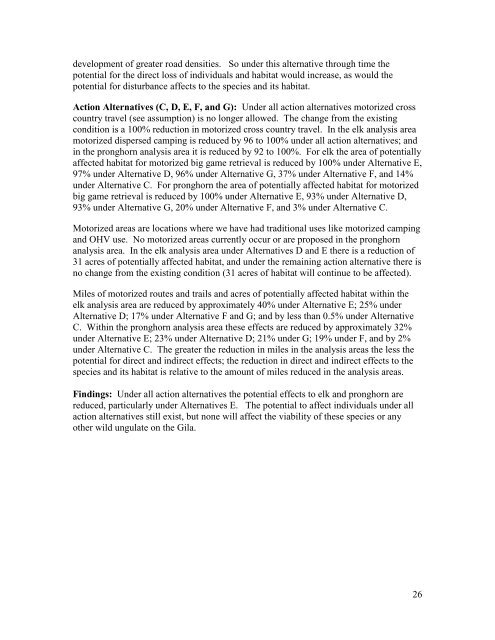Wildlife Specialist report
Wildlife Specialist report
Wildlife Specialist report
You also want an ePaper? Increase the reach of your titles
YUMPU automatically turns print PDFs into web optimized ePapers that Google loves.
development of greater road densities. So under this alternative through time the<br />
potential for the direct loss of individuals and habitat would increase, as would the<br />
potential for disturbance affects to the species and its habitat.<br />
Action Alternatives (C, D, E, F, and G): Under all action alternatives motorized cross<br />
country travel (see assumption) is no longer allowed. The change from the existing<br />
condition is a 100% reduction in motorized cross country travel. In the elk analysis area<br />
motorized dispersed camping is reduced by 96 to 100% under all action alternatives; and<br />
in the pronghorn analysis area it is reduced by 92 to 100%. For elk the area of potentially<br />
affected habitat for motorized big game retrieval is reduced by 100% under Alternative E,<br />
97% under Alternative D, 96% under Alternative G, 37% under Alternative F, and 14%<br />
under Alternative C. For pronghorn the area of potentially affected habitat for motorized<br />
big game retrieval is reduced by 100% under Alternative E, 93% under Alternative D,<br />
93% under Alternative G, 20% under Alternative F, and 3% under Alternative C.<br />
Motorized areas are locations where we have had traditional uses like motorized camping<br />
and OHV use. No motorized areas currently occur or are proposed in the pronghorn<br />
analysis area. In the elk analysis area under Alternatives D and E there is a reduction of<br />
31 acres of potentially affected habitat, and under the remaining action alternative there is<br />
no change from the existing condition (31 acres of habitat will continue to be affected).<br />
Miles of motorized routes and trails and acres of potentially affected habitat within the<br />
elk analysis area are reduced by approximately 40% under Alternative E; 25% under<br />
Alternative D; 17% under Alternative F and G; and by less than 0.5% under Alternative<br />
C. Within the pronghorn analysis area these effects are reduced by approximately 32%<br />
under Alternative E; 23% under Alternative D; 21% under G; 19% under F, and by 2%<br />
under Alternative C. The greater the reduction in miles in the analysis areas the less the<br />
potential for direct and indirect effects; the reduction in direct and indirect effects to the<br />
species and its habitat is relative to the amount of miles reduced in the analysis areas.<br />
Findings: Under all action alternatives the potential effects to elk and pronghorn are<br />
reduced, particularly under Alternatives E. The potential to affect individuals under all<br />
action alternatives still exist, but none will affect the viability of these species or any<br />
other wild ungulate on the Gila.<br />
26
















